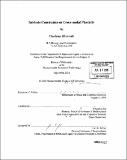Intrinsic constraints on cross-modal plasticity
Author(s)
Ellsworth, Charlene
DownloadFull printable version (7.235Mb)
Other Contributors
Massachusetts Institute of Technology. Dept. of Brain and Cognitive Sciences.
Advisor
Mriganka Sur.
Terms of use
Metadata
Show full item recordAbstract
Over the last two decades numerous examples have demonstrated the remarkable plasticity of the developing brain. This plasticity occurs from the level of a single synapse to the repatterning of sensory input. One paradigm that demonstrates this plasticity is the re-routing of sensory input to inappropriate targets. This cross-modal plasticity in an animal model is reminiscent of similar rearrangements in deaf and blind human patients. In these animal models, visual input is induced to innervate the auditory or somatosensory thalamus, MGN and VB respectively, as a result of deafferentation of these nuclei. Such experiments have demonstrated that structures are influenced by their input, and therefore sensory input is able to use alternative pathways for function. This thesis examines the extent to which cues intrinsic to the target provide information to these novel retino-MGN projections. It will consider two examples in which the target structure imposes order onto the incoming sensory input; via intra-nuclei patterning and via a behaviorally relevant efferent pathway. We demonstrate that retinal axons use an ephrin gradient present in the MGN to acquire orderly connections, akin to retinal patterning in visual targets. Using fear conditioning, we show that learning of a visual cue changes when visual input is routed through the auditory pathway. To better understand the intrinsic cues present in a target, we identify a set of genes differentially expressed in the LGN and MGN, which includes a list of transcription factors and putative downstream targets. (cont.) Furthermore, we demonstrate that deafferentation of the MGN does not influence these sensory-specific molecular profiles but does create a permissive environment which induces innervation by local axons.
Description
Thesis (Ph. D.)--Massachusetts Institute of Technology, Dept. of Brain and Cognitive Sciences, 2004. Includes bibliographical references (p. 120-125).
Date issued
2004Department
Massachusetts Institute of Technology. Department of Brain and Cognitive SciencesPublisher
Massachusetts Institute of Technology
Keywords
Brain and Cognitive Sciences.